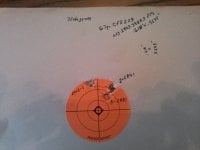truck driver
Ammo Smith
- Mar 11, 2013
- 7,412
- 1,109
I got the good DrMike to run me some QLs on CFE223 for the 35 Whelen Ack Imp and I'm glad he did.
Shooting 3 shot groups to get a velocity average I came up with 2902.33333fps with 66.0grs of CFE223out of my 24" barrel the group size was .368"X.404", OAL for the 200gr AB was 3.395" which is the length for a this bullet seated to caliber diameter of .358". I think I found a node with this load since the velocity spread was very tight.(2907-2907-2893)
Next up was 67.0grs of CFE223 with the 200gr AB and the velocity was 2893.33333fps :?: :?: :?: :?: Why was it slower then a lesser grain load of the same powder in the same brass with the same bullet :?:
The group size was .618"X.9595".
Out of a cold clean barrel I shoot some H322 under the 200gr Ab seated to a OAL of 3.395".
57.5grs avg 2835.66667fps and the groups size was 1.583"X.8115" this is miss leading because I either pulled the 3rd shot or it was a flier since the first two were cutting each other but I also found later while closely inspecting my brass I had pressure signs with this load which was the ejector slot of the bolt face nicely imprinted on the base of the brass.
58.0grs of H322 was a little better with a avg velocity of 2921.66667fps the group size shrank to .235"X.480" But here again I had pressure signs and the ejector slot of the bolt face was imprinted on the brass or should I say the brass flowed into the ejector slot. ( see inclosed pics of all six pieces of brass used for H322 load ) the light glare makes it hard to see the ejector slot marks on the brass.
I took some pics of the targets for your review and thoughts.
Shooting 3 shot groups to get a velocity average I came up with 2902.33333fps with 66.0grs of CFE223out of my 24" barrel the group size was .368"X.404", OAL for the 200gr AB was 3.395" which is the length for a this bullet seated to caliber diameter of .358". I think I found a node with this load since the velocity spread was very tight.(2907-2907-2893)
Next up was 67.0grs of CFE223 with the 200gr AB and the velocity was 2893.33333fps :?: :?: :?: :?: Why was it slower then a lesser grain load of the same powder in the same brass with the same bullet :?:
The group size was .618"X.9595".
Out of a cold clean barrel I shoot some H322 under the 200gr Ab seated to a OAL of 3.395".
57.5grs avg 2835.66667fps and the groups size was 1.583"X.8115" this is miss leading because I either pulled the 3rd shot or it was a flier since the first two were cutting each other but I also found later while closely inspecting my brass I had pressure signs with this load which was the ejector slot of the bolt face nicely imprinted on the base of the brass.
58.0grs of H322 was a little better with a avg velocity of 2921.66667fps the group size shrank to .235"X.480" But here again I had pressure signs and the ejector slot of the bolt face was imprinted on the brass or should I say the brass flowed into the ejector slot. ( see inclosed pics of all six pieces of brass used for H322 load ) the light glare makes it hard to see the ejector slot marks on the brass.
I took some pics of the targets for your review and thoughts.












